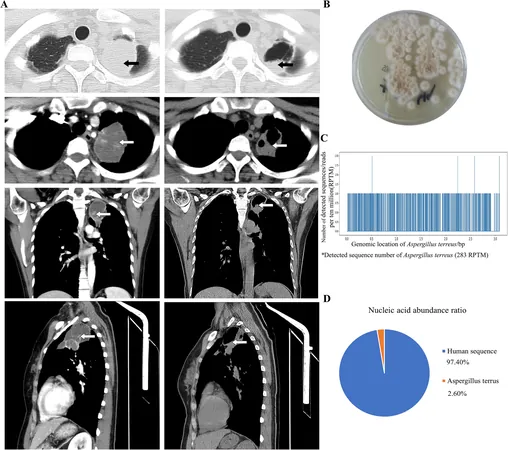
Unveiling the Mystery: Asymptomatic Aspergillus Lung Abscess in a Healthy Woman – A Rare Case Study
2025-01-14
Author: Siti
Introduction
While chronic pulmonary abscesses typically arise from bacterial or mycobacterial infections, cases involving the fungus Aspergillus are exceedingly rare, especially in individuals without prior lung disease or compromised immune systems. Here we explore an astonishing case of a healthy 43-year-old woman who was found to have an asymptomatic lung abscess caused by Aspergillus terreus, challenging our understanding of fungal infections and lung health.
The Case: A Surprising Discovery
This intriguing case centers on a 43-year-old female patient who underwent a routine chest CT scan after a month of incidental findings. The scan revealed a mass shadow in the apical posterior segment of her left upper lung lobe, characterized by a central liquid anechoic area. Surprisingly, she reported no respiratory symptoms such as cough, sputum production, or any systemic discomfort.
A thorough medical history revealed no significant risk factors—she was a non-smoker with no history of alcohol or drug abuse, and she had not experienced any chronic illnesses, including diabetes or autoimmune disorders. Previous chest CT scans had also shown no abnormalities, indicating her lungs had been healthy prior to this incident.
When laboratory tests showed no signs of infection, with normal white blood cell counts and no raised inflammatory markers, a percutaneous abscess puncture was performed, yielding 30 milliliters of yellow purulent fluid. Subsequent analyses confirmed the presence of Aspergillus terreus through both fluid culture and cutting-edge metagenomics next-generation sequencing, along with a positive Galactomannan antigen test.
Understanding the Rarity: Why This Matters
Aspergillus lung abscesses are extremely rare, particularly in individuals without a pre-existing lung cavity or immune suppression. Traditional presentations of lung abscesses typically encompass cough and sputum production, pointing towards an infectious process most often attributed to bacteria. However, the lack of symptoms in this patient raises critical questions about our understanding of fungal infections in otherwise healthy people.
Chronically, lung abscess formation is thought to require pre-existing lung damage, such as from tuberculosis or chronic obstructive pulmonary disease; however, this patient’s case defies those expectations. This raises essential discussions about fungal exposure in everyday environments—hundreds of Aspergillus spores can be inhaled daily, and whether they cause infection is largely determined by the host’s immune response.
Treatment Approach: A Conservative Route
Given the patient's preference and the abscess's proximity to major vessels and airways, a conservative treatment approach was adopted. This included catheterization and drainage of the abscess, along with six months of antifungal therapy using voriconazole. Remarkably, this strategy led to significant improvement, with follow-up CT scans revealing resolution of the abscess and a return to normal lung architecture.
In stark contrast to surgical interventions—which carry considerable risks, including high rates of complications and mortality—the conservative strategy proved effective and non-invasive for this patient.
Conclusion: Rethinking Asymptomatic Lung Infections
This extraordinary case underscores the importance of vigilance among clinicians when evaluating lung masses—even in patients with no traditional risk factors or symptoms. Asymptomatic Aspergillus lung abscesses, though rare, can occur and may evade common diagnostic considerations.
This patient's story serves not only as a unique clinical finding but also as a reminder of the complexities of pulmonary health. As research evolves, understanding the variances in fungal infections will be crucial for shaping diagnostic and treatment approaches. Health practitioners must maintain an open mind, as the absence of symptoms does not equate to an absence of significant health issues.
Stay tuned for more intriguing medical case studies that challenge our understanding of the human body!


 Brasil (PT)
Brasil (PT)
 Canada (EN)
Canada (EN)
 Chile (ES)
Chile (ES)
 Česko (CS)
Česko (CS)
 대한민국 (KO)
대한민국 (KO)
 España (ES)
España (ES)
 France (FR)
France (FR)
 Hong Kong (EN)
Hong Kong (EN)
 Italia (IT)
Italia (IT)
 日本 (JA)
日本 (JA)
 Magyarország (HU)
Magyarország (HU)
 Norge (NO)
Norge (NO)
 Polska (PL)
Polska (PL)
 Schweiz (DE)
Schweiz (DE)
 Singapore (EN)
Singapore (EN)
 Sverige (SV)
Sverige (SV)
 Suomi (FI)
Suomi (FI)
 Türkiye (TR)
Türkiye (TR)
 الإمارات العربية المتحدة (AR)
الإمارات العربية المتحدة (AR)